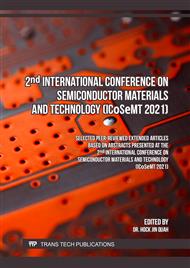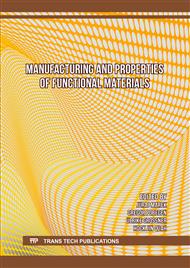p.53
p.61
p.67
p.75
p.81
p.89
p.97
p.103
p.109
Impedance and Dielectric Characterization of Epoxy Composites Containing Carbon Black and Carbon Nanotubes
Abstract:
Research in improving dielectric materials is rapidly becoming more intense as there are higher demands for novel materials with the ability to store charges. In this work, impedance characterisation and dielectric properties of epoxy composites containing Carbon Black (CB) and a mixture of CB and Carbon Nanotube (CNT), kept at 1:1 wt.% is conducted. For both cases, the total number of fillers are varied from 0.5 wt.% to 6 wt.%. At 20 Hz, the values of dielectric composites, k was recorded to be 2050 for 6 wt.% CB, compared to k = 600, for composites containing dual filler (3 wt.% CB + 3 wt.% CNT). Further analysis revealed that the 6 wt.% sample (CB + CNT) exhibited higher ac conductivity at lower frequency, compared to sample containing only 6 wt.% CB. This could be due to the reason that CNT has more conductivity effects while CB has more storage or capacitive effects. Nyquist plot of impedance for both fillers also revealed the formation of semi-circular shapes for 5 wt.% and 6 wt.%; for both CB and CB + CNT fillers. However, formation of smaller semi-circular shapes is observed for CB + CNT, compared to CB only, indicating formation of conductive network in dual filler composites. This study highlights the potential of CB in enhancing mainly the dielectric properties of epoxy composites.
Info:
Periodical:
Pages:
89-94
Citation:
Online since:
June 2023
Price:
Сopyright:
© 2023 Trans Tech Publications Ltd. All Rights Reserved
Share:
Citation:



